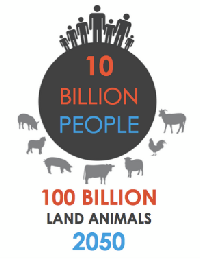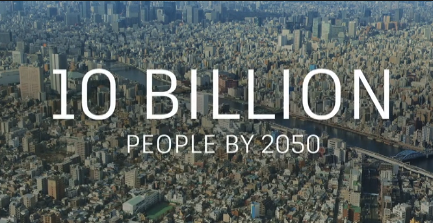WATER AND AGRICULTURE
The definition of agriculture: The raising of crops and livestock for food.
It is estimated that over 70 percent of freshwater is used for agriculture. By 2050, feeding a planet of 10 billion people will require an estimated 55 percent increase in agricultural production.
LIMITING FACTORS OF FOOD PRODUCTION
The limiting factors of food production
- The availability of fresh water
- The availability of crops nutrition
- Arable futile soils
FRESH WATER OR HOW TO FEED 10 BILLION PEOPLE BY 2050 IN A WARMING WORLD?
The global shortage of the fresh water in the nearby future is eminent and and has become already a social and humanist disaster. Periodical droughts in the main foods producing regions are causing severe economic and environmental impacts. Eventually leading to aggravation of national and international conflicts.
INCREASING WATER DEMAND
 Water demand is projected to increase by 55% globally between 2000 and 2050.
Water demand is projected to increase by 55% globally between 2000 and 2050.
The increase in demand will come mainly from
GREAT THREATS:
SHORTAGE AGRICULTURE AND URBAN WATER SUPPLIES EMINENT
- Groundwater depletion has already become the greatest threat to agriculture and urban water supplies. The demand doubled more then twice between 1960 and 2000.
DETERIORATING WATER QUALITY
- The quality of surface water will deteriorate, leading to increased excessive plant and algal growth, loss of bio-diversity and increasing diseases. Micro-pollutants (medicines, cosmetics, cleaning agents, pesticides and biocide residues) are an emerging concern.
NO BASIC SANITATION
- Discrepancy between urbanisation and development of infrastructure.
- Projections indicate that 1.4 billion people will have no access to basic sanitation in 2050, causing severe consequences on health and environment.
THE WEATHER PENDULUM BETWEEN INTENSE DROUGHTS AND FLOOD
- As our warming atmosphere holds more water vapour - hence more heat/energy- the weather phenomena become more intense.
- Resulting in a increasing number of droughts, intense storms, and floods, that poses risks to public health, food production and overall our future.
- The number of people at risk from floods is projected to rise from 1.2 billion today to around 1.6 billion in 2050 (nearly 20% of the world’s population in 2050).
ANTICIPATING ON WATER SHORTAGE
A number of initiatives have already taken place.
Flexible mechanisms are required to allocate water where it is needed.
Infra-structural technologies such as water storage facilities, groundwater recharge, flood plains,water-related services and wetlands restoration are available and introduced.
GLOBAL WARMING WILL OUTRUN CURRENT WATER ADAPTATION
But despite all efforts:
- The ongoing rise of global temperature will partially diminish the effectiveness of mentioned water infrastructures because of the higher rate of evaporation.
- Global warming in its self is causing the atmosphere to hold more water vapour (energy) en thereby intensifying and the duration of weather phenomena.
- The demand for more fresh water

GREEN HOUSE EFFECT
CO2 sticks around
 CO2 remains in the atmosphere longer than the other major heat-trapping gases emitted as a result of human activities. It takes about a decade for methane (CH4) emissions to leave the atmosphere (it converts into CO2) and about a century for nitrous oxide (N2O).
CO2 remains in the atmosphere longer than the other major heat-trapping gases emitted as a result of human activities. It takes about a decade for methane (CH4) emissions to leave the atmosphere (it converts into CO2) and about a century for nitrous oxide (N2O).
After a pulse of CO2 is emitted into the atmosphere, 40% will remain in the atmosphere for 100 years and 20% will reside for 1000 years, while the final 10% will take 10,000 years to turn over. This literally means that the heat-trapping emissions we release today from our cars and power plants are setting the climate our children and grandchildren will inherit.
Read more...
DRINKING WATER WILL BECOME THE NEW OIL
 Studies and analyses done by the Moscow State Institute of International Relations (MGIMO) in 2011 showed that that an acute shortage of drinking water may occur earlier than that of the oil leading to the aggravation of national and international conflicts.
Studies and analyses done by the Moscow State Institute of International Relations (MGIMO) in 2011 showed that that an acute shortage of drinking water may occur earlier than that of the oil leading to the aggravation of national and international conflicts.
Read more...
FRESHWATER STRICTLY LIMITED
 FRESH WATER JUST 2,5% OF ALL WATER
FRESH WATER JUST 2,5% OF ALL WATER
Abundant water exists on our planet,
97.5 % is salt water in the oceans.
freshwater just 2.5 %!
Read more...






 Water demand is projected to increase by 55% globally between 2000 and 2050.
Water demand is projected to increase by 55% globally between 2000 and 2050. 
 CO2 remains in the atmosphere longer than the other major heat-
CO2 remains in the atmosphere longer than the other major heat- GROUNDWATER DEPLETION IS ACCELERATING
GROUNDWATER DEPLETION IS ACCELERATING
